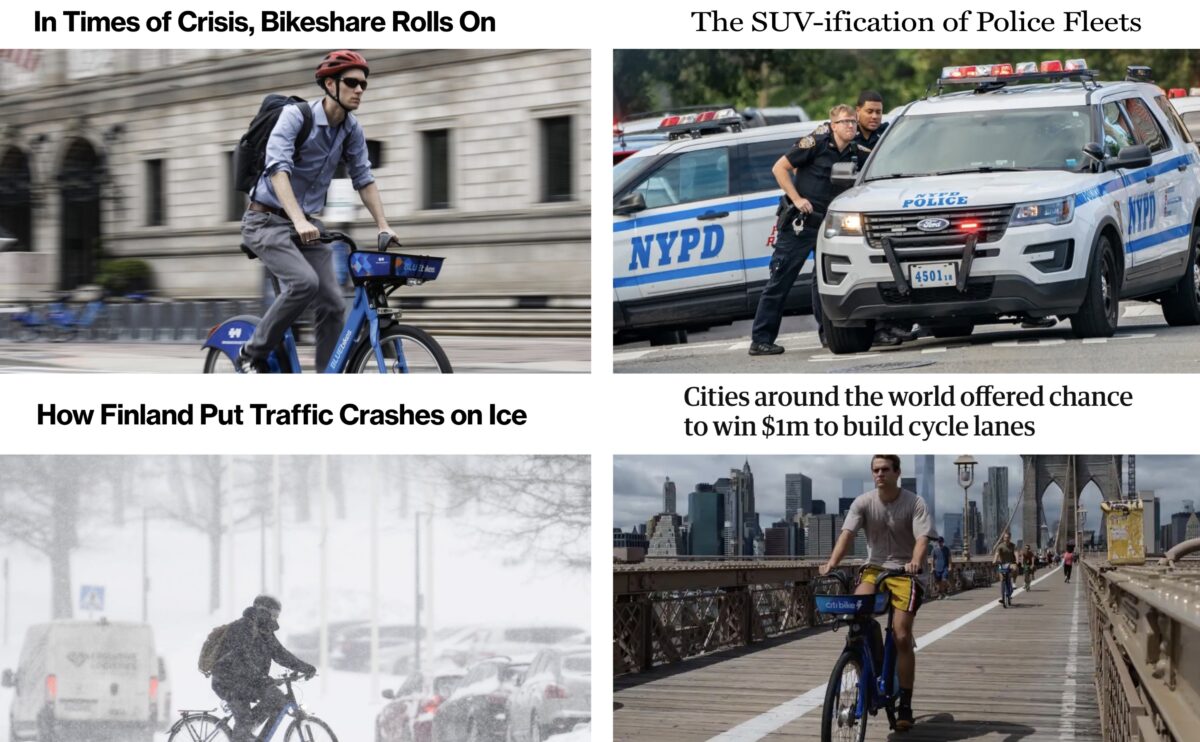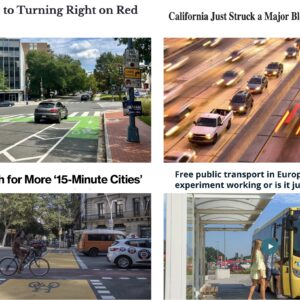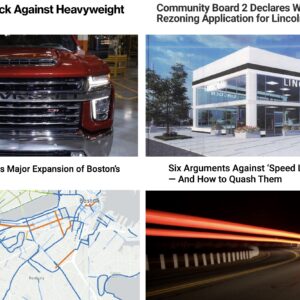Welcome to the week.
Here are the most notable stories our writers and readers came across in the past seven days…
“Aggressively experimental”: When Boston shut down a major subway line, they boosted support and space for non-driving alternatives and it worked so well they’ve made some of the changes permanent. (Governing)
Bike share resiliency: As climate disasters befall more cities, those with high-quality bike share systems can rest easy knowing that municipal bike rental programs are likely to be the last mode standing. (Bloomberg)
Bike aid stations: New York City will launch a program to create aid stations out of old newsstands for bicycle delivery workers. (Time Out)
City haters: “Republicans don’t actually have any ideas about solving crime. They just want to revel in its rise,” pretty accurately describes a lot of city haters making noise in Portland these days. (Slate)
EV tax: Curious what gubernatorial candidates think about tolls? Both Tina Kotek and Christine Drazan agree that e-car drivers need to be paying more of their fair share. (Portland Tribune)
Bike lane money: Any city with a population of over 100,000 can apply for a $1 million grant to build bike lanes thanks to a new initiative from Bloomberg Philanthropies spearheaded by former NYC DOT commish Janette Sadik-Khan. (Guardian)
Vehicle arms race: As vulnerable road users, it behooves bicycle riders to know why police vehicle fleets are moving toward larger and larger SUVs. (Curbed)
Helsinki how-to: Decades ago, leaders in Helsinki made an intentional choice to not become a car-centric dystopia and they coupled that with strong anti-speeding policies and a solid transit and biking system so that today they have very safe streets. (Bloomberg)
Video of the Week: Don’t miss this detailed tour of the I-205 bike path from Bike Stuff:
Thanks to everyone who shared links this week!







Thanks for reading.
BikePortland has served this community with independent community journalism since 2005. We rely on subscriptions from readers like you to survive. Your financial support is vital in keeping this valuable resource alive and well.
Please subscribe today to strengthen and expand our work.
I’ve become a city hater (USAnian urban centers) because they have come to epitomize the rapid growth of inequality and dehumanization of poor people in the USA. Suburban areas have been more resistant to this rapid growth in inequality so I have become less of a hater of suburbs.
https://theconversation.com/income-inequality-is-getting-worse-in-us-urban-areas-132417
While the headline correctly notes that inequality has gotten worse in more urban counties, it also got worse in rural and exurban counties. The least rural counties had almost as much increase in Gini coefficient as the most urban counties, and all types of counties are now at a Gini coeffficient of 0.43 or 0.44, except for “moderately urban” ones – which are implied to be “suburban”, though those still have a 0.4 which is not much less.
However, this article doesn’t say anything about the actual median income of each county. My supposition is that the suburban counties with less equality have uniformly high incomes: everyone is upper middle class. Supporting this idea, the map in the article shows only one blue (low inequality) county in the whole Northeast metro area (Washington to Boston), and this is Loudoun county Virginia, a suburban county with median household income of $147,111 – one of the highest in the country. It’s not an equality place, it’s a suburb that has managed to exclude the poor from the entire county.
That’s why looking at gini coefficients for USA counties is foolish. It would only be useful to look at whole metro areas. In the USA the rich and upper middle class can create uniformity by exclusion, but this should not be mistaken for actual equality. https://theconversation.com/income-inequality-is-getting-worse-in-us-urban-areas-132417
You’re correct, of course, but that doesn’t fit the edgy narrative trying to be pushed in this comment.
Nice whataboutism.
Do you understand the difference between rapid growth and little change (albeit from too high levels)
There is an awful lot whataboutism in your comment.
I did not comment on rural inequality but, yes, I hate the long-term trend of stable rural inequality too but I hate the sharp increase in inequality in urban areas even more.
These geographic boundaries were chosen based on existing data sets but I can understand how you might not like the results.
Which is more evidence-based? The unsupported critique of an anonymous internet commenter or the methodologies used in a peer-reviewed study and a Fed working paper?
https://onlinelibrary.wiley.com/doi/abs/10.1111/ruso.12354
https://www.newyorkfed.org/medialibrary/media/research/epr/2019/epr_2019_wage-inequality_abel-deitz.pdf
Fun of you to skip over that part.
I skipped over it because the publications described show that the Gini coefficient of urban areas has increased. This means that, in stark contrast to Joseph’s completely unsupported opinion, the inequality of the frequency distribution in urban areas has increased (not become homegenized). Moreover, much of this increase is attributed to the sharp rise in median income (and wealth) of urban residents. Or is it that you dispute the fact that Portland (and other west coast cities) has seen a massive increase in median wealth and a hollowing out (diplacement) of lower-income and precarious working class demographics?
After all of this, what is the point of your comment in the first place, even? You hate cities now? So you are moving out of Portland? Or you’ve already moved out and won’t be commenting on BikePortland anymore?
Re: vehicle arms race
Another concerning thing is that not only are the police using larger vehicles, they are also using, what I assume is, more ‘intimidating’ color palettes.
This is an SUV police car in London

This is an SUV police car in Portland
http://media.oregonlive.com/oregonian/photo/2015/09/30/-b1cd1c152a1a806f.JPG
They literally chose dark blue for an emergency vehicle in a place where the natural color palette is grey and dark 8 months of the year. Every time I see them driving with their lights off in the rain or speeding down the street playing on their computers or phones, I think about how hard their vehicles are to see, solely because they want to look bad-azz
Insightful.
It’s what they do with uniforms, too–walking around at crash scenes at night in the rain wearing dark clothes, issuing reports blaming victims for walking around in the rain at night wearing dark clothes.
Because reflective vests are for nerds. You aren’t a nerd, are you?
-some cop
On bike share resilience: what is the likelihood that Portland’s bike share would continue to work after a natural disaster that wipes out power and cell phone communications, at least for several days? The sort of interruptions of transit mentioned in the article (flood, metro repair) did not also take out their cities’ electrical grid. Is there an unpowered, offline alternative way to access BikeTown? Seems like a lot of bike share’s resilience depends on disruptions not being total disruptions.
If bikes are broken, I’ll take a scooter.
I am not sure if it is willful naivete or intentional cognitive dissonance, but it takes a special amount of mental gymnastics to believe the people with literally the least possible ability to contribute to the problems in Portland and other large cities with decades of Democrat leadership, should be the ones responsible for identifying solutions to the problems. Even worse is the acute inability to look critically at many of the decisions made by both council and referendum in the last 10 years and not be able to draw any connection between those decisions and negative consequences.
Love that video of the week. But wait, I thought the 205 path was impassible with the end of times! They made great points about the inadequacy of wayfinding designs for bike routes.
I also really appreciated that they showed how bad a lot of the crossings are. There are places where you have to wait through several signal cycles in order to cross!
The video only covers the southern portion of the trail, from Powell south.
Go ahead and ride out this weekend and hit the section between Stark and Glisan (bonus points if you can actually stay on the trail between Burnside and Glisan), then try to get all the way up to Marine Drive without diverting onto local streets. The underpasses for Prescott, and the railroad tracks are especially fun.
From the Bloomberg piece on the Finns:
Oh, to dream!
I would really like to see a similar way-finding video of how to get to and from the I-5 bridge. I used to do it pretty regularly, but yesterday I got totally turned around.